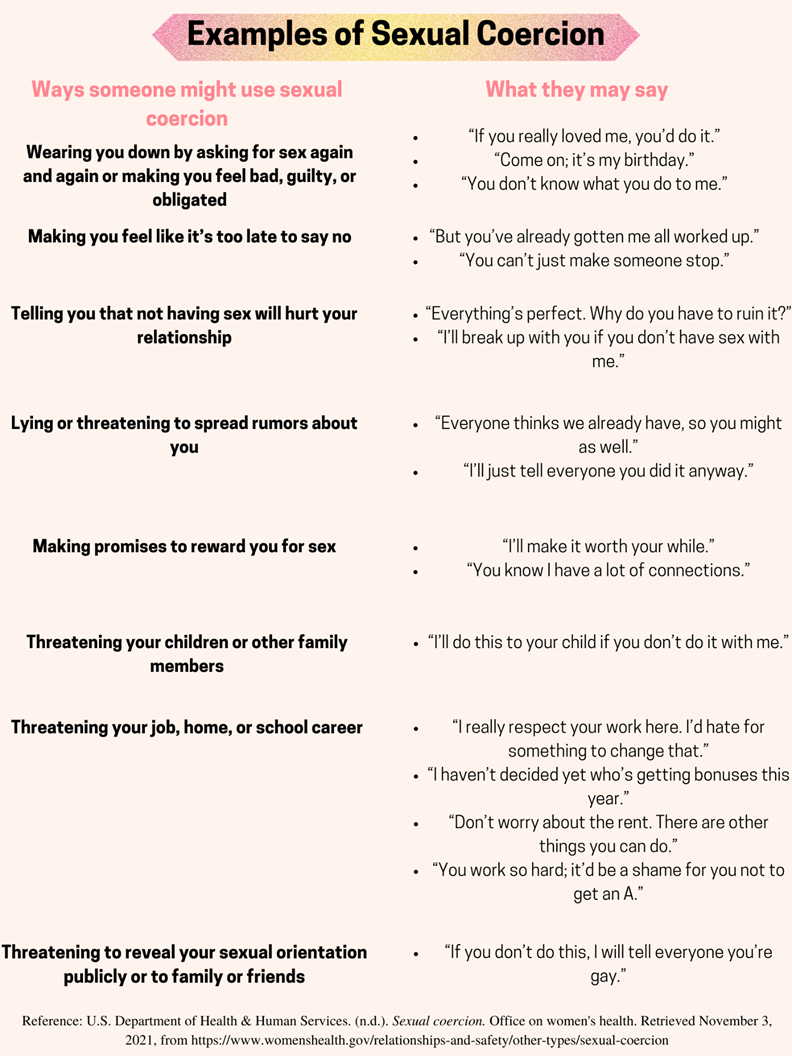14.3: Sexual Coercion
- Page ID
- 167241
You should now have a clearer understanding of healthy relationships and that consent must be prevalent within them. We will now examine sexual coercion and how it can present in relationships and environments you may be in. Sexual coercion is, ‘“the act of using pressure, alcohol or drugs, or force to have sexual contact with someone against their will” and includes “persistent attempts to have sexual contact with someone who has already refused”’ (What is Sexual Coercion, n.d.).
Sexual coercion can range from someone wearing you down verbally into consent, using actual force, to using guilt or shame tactics in order to have sexual contact with them (What is Sexual Coercion, n.d.). Those who attempt to coerce can be a spouse, employer, or friend for example.

There can be instances of coercion within relationships, such as reproductive coercion along with sexual coercion. This can be defined as, “pressuring someone to have sex or messing with their birth control to cause a pregnancy” (What is sexual and reproductive control, n.d.). Examples of reproductive coercion can include: breaking condoms, lying about using birth control, forcing a partner to have an abortion, or carrying a pregnancy to term (What is sexual and reproductive control, n.d.). If you are in a relationship, that does not mean you have to partake in sexual activities out of duty or because you are in love [that is coercion]; if you are forced to have sex, it is rape (What is sexual and reproductive control, n.d.). Rape is a form of sexual assault, that can be defined as, sexual penetration without consent (Sexual Assault, n.d.).
When consent is not granted or forced upon an individual, a physical boundary has been breached, and a sexual assault has been committed.
There is a huge cultural difference in terms of which acts are criminalized and punished. The word “rape” is defined differently in different cultures. In some cultures, spousal rape does not exist from a legal standpoint.
I’ve lived a long life in this body, and have experienced many different coercive situations in which I have had a sexual encounter that was unwanted. Whatever the coercive factors may be, being pressured into doing something you don’t want to do is traumatizing. At this point in my life, there are too many to count, but as I reflect back on a recent encounter, I am filled with sadness. He was one of my best friends. The loss of our friendship is one of the things I still grieve.
We were colleagues of over 10 years, and shared a passion for social justice. We were presenting together at a conference and had a shared room with two beds in a hotel. I was having a great time hanging out with my buddy and talking late into the night. On the first night he asked if we could have sex. He went into this long fantasy he’d been having about being with me sexually and that he wanted to tell his wife that he wanted an open relationship and that I could be his regular hookup when he was in town. I said no. He persisted. I said no. On the second night after our presentation a group went out and had dinner and drinks and when we got back to the room he asked again. I said no. He persisted, and persisted. I was pretty drunk and tired of him persisting. I said yes. We began, and part way through I said no. He stopped but continued to bring it up. I finally fell asleep, but when I woke up in the morning, he seemed to feel entitled to a more intimate friendship than I was comfortable with. He was seriously envisioning a continued hookup. It became clear that I could not retain what I thought was a solid friendship, and that much of our past work collaborations and connections was based in his desire to have a sexual relationship. Not only do I feel sad about losing a friend, I feel duped. I thought that for all these years, he viewed me as a valuable colleague, but in reality, he was just waiting to hook up.
Coercive encounters are often enhanced by gender scripts that we feel the need to follow. For me, I didn’t want to hurt his feelings because I am supposed to be nice. Additionally, my work is within a predominantly cis-white male field, and my validity as a scholar gets called into question regularly, which feeds into my imposter syndrome. So when I realized that that was his objective all along, and that he did not see me as a respected colleague, it reinforced the notion that I don’t belong.


